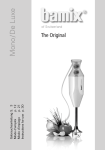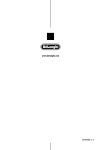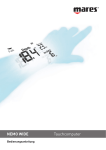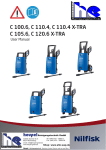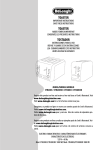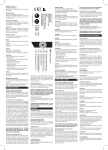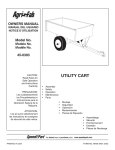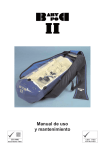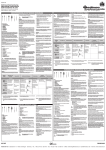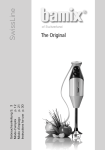Download Chirurgische Bohrer mit Tiefenstopp Foret
Transcript
Gebrauchsanweisung Chirurgische Bohrer mit Tiefenstopp D Bitte diese Gebrauchsanweisung vor dem Produkteinsatz ausführlich lesen! Für Schäden, die durch Nichtbeachtung dieser Gebrauchsanweisung entstehen, lehnt der Hersteller jede Haftung ab. 1. Produktbeschreibung Chirurgische Bohrer mit Tiefenstopp und Außenkühlung für das SKY System 2. Indikation/ Einsatzbereich Zur Aufbereitung des Implantatbettes für das SKY classic, blueSKY, narrowSKY und miniSKY Implantatsystem von bredent medical. 3. Kontraindikation Andere Implantatsysteme außer die unter Punkt 2 genannten. Wenn keine Kontraindikationen bekannt sind: Nach gegenwärtigem Kenntnisstand sind keine Kontraindikationen bekannt. Bei Verdachtsmomenten auf Unverträglichkeit darf dieses Produkt nur nach vorheriger allergologischer Abklärung und Nachweis des Nichtbestehens einer Allergie verwendet werden. 4. Sachgemäßer Gebrauch speziell für den Einsatz in der Zahnarztpraxis • Es ist darauf zu achten, nur hygienisch einwandfreie, gereinigte Hand- und Winkelstücke einzusetzen. • Die Instrumente sind so tief wie möglich einzuspannen. • Die Instrumente sind vor dem Ansetzen an das Objekt auf Drehzahl zu bringen. • Verkanten oder Hebeln der Instrumente führt zu erhöhter Bruchgefahr und ist zu vermeiden. • Je nach Anwendung Schutzbrille tragen. • Die ungeschützte Berührung der Instrumente durch den Anwender ist zu vermeiden (Schutzhandschuhe tragen). • Thermische Schäden des Gewebes durch rotierende Instrumente sind unbedingt zu vermeiden (empfohlene Drehzahl einhalten und mit ausreichender Kühlung arbeiten) 5. Sicherheit und Haftung Abgenutzte und beschädigte Bohrer sind umgehend auszusortieren und durch Neue zu ersetzen. Die genannten Empfehlungen zur Handhabung, Kühlung und Anpresskraft sind unbedingt einzuhalten. Die Instrumente dürfen nur für den angegebenen Verwendungszweck eingesetzt werden. Bei Missachtung dieser Sicherheitshinweise kann es zur Schädigung des Antriebes oder Verletzungen kommen. Der Anwender ist verpflichtet, das Produkt eigenverantwortlich vor dem Einsatz auf die Eignung für den vorgesehen Zweck zu prüfen. Ein Mitverschulden des Anwenders führt bei verursachten Schäden zur Minderung oder gänzlichen Ausschluss der Haftung von bredent medical. Dies ist insbesondere bei Nichtbeachtung der Gebrauchsanweisung, Warnungen oder bei versehentlichem Fehlgebrauch durch den Anwender der Fall. Die Lotnummern aller verwendeten Teile müssen zur Gewährleistung der Rückverfolgbarkeit und Reklamationsansprüchen dokumentiert werden. Außerhalb der Reichweite von Kindern aufbewahren. Nur für den dentalen Gebrauch. 6. Lagerungs- und Haltbarkeitshinweise Trocken aufbewahren. Sterilverpackungen sind auf Unversehrtheit zu überprüfen. Beschädigte Verpackungen sind nicht mehr zu verwenden. 7. Verarbeitung Anwendung Tiefenstopp: Die Tiefenstopps sind entsprechend der gewünschten Bohrtiefe auf die Bohrer aufzustecken. Dabei ist darauf zu achten. dass die Tiefenstopps bis zum Anschlag auf den Bohrern sitzen. Drehzahlempfehlung: Geeignet für chirurgische Winkelstücke Pilotbohrer/Twistdrill: 800-1000 Rpm Final Drill: 300 Rpm Crestalbohrer: 300 Rpm Anpresskräfte: Überhöhte Anpresskräfte (>2N) sind unbedingt zu vermeiden. • Sie können bei schneidenden Instrumenten zur Beschädigung des Arbeitsteils mit Schneideausbrüchen führen. Gleichzeitig tritt eine erhöhte Wärmeentwicklung ein. • Überhöhte Anpresskräfte können auch zu thermischen Schäden Weichgewebe und Knochen führen. Im Extremfall kann auch ein Instrumentenbruch nicht ausgeschlossen werden. Kühlung: Zur Vermeidung unerwünschter Wärmeentwicklung bei der Präparation ist eine ausreichende Kühlung mit Wasserspray (min. 50 ml/min) sicherzustellen. Bei unzureichender Wasserkühlung kann es zu einer irreversiblen Schädigung des Gewebes kommen. Richtwert für die Einsatzhäufigkeit rotierender Instrumente: Die folgenden Werte sind Richtwerte, die je nach Anwendung und Knochenqualität von der tatsächlichen Standzeit abweichen können. Die Instrumente können mitunter länger eingesetzt werden, sofern keine Abnutzung sichtbar ist. Einsatzhäufigkeit bei allen Instrumente bis zu 4mal. 8. Aussortierung von abgenutzten Instrumenten Beschädigte und verformte Schneiden verursachen Vibrationen und führen zu schlechten Präparationsergebnissen und rauen Oberflächen. Sehr wichtig: Stumpfe und ausgebrochene Instrumente verleiten den Zahnarzt zu hohen Anpresskräften und erhöhen so die Arbeitstemperatur. Dies kann zu einer Schädigung des Gewebes und des Knochens führen. Beschädigte Instrumente sind daher unverzüglich auszusortieren. 9. Reinigung, Desinfektion und Sterilisation Die Instrumente sind mit Desinfektions- und Reinigungsmittel für rotierende Instrumente mit Korrosionsschutz zu desinfizieren (z.B. mit Komet DC1). Die Gebrauchsanweisung (Einwirkdauer, Konzentration, Eignung) für Desinfektions- und Reinigungsmittel sind den Angaben der Hersteller dieser Mittel zu entnehmen. Das Desinfektions- und Reinigungsmittel sehr gründlich mit Wasser abspülen und die Instrumente sorgfältig trocknen (z.B. mittels Luftstrom). Instrumente nie feucht oder nass länger liegen lassen. Bei der Reinigung im Ultraschall dürfen sich die Instrumente nicht gegenseitig berühren. Gereinigte Instrumente optisch prüfen. Die Aufbereitung im Thermodesinfektor ist möglich, sofern ein entsprechendes Mittel verwendet wird, das für rotierende Instrumente geeignet ist (z.B. Komet DCTherm, mildalkalischer Reiniger). Gereinigte Instrumente einer optischen Prüfung unterziehen. Beschädigte oder stumpfe Instrumente aussortieren und nicht mehr verwenden. Die Sterilisation erfolgt im Autoklav bei 134°C. Die vom entsprechenden Gerätehersteller angegebenen Hinweise sind zu beachten. Korrodierte Instrumente nicht mehr verwenden. Dem Medizinproduktebetreiber obliegt die Verantwortung, dass die Aufbereitung mit geeigneter Ausstattung, geeigneten Materialien und entsprechend qualifiziertem Personal durchgeführt wird. 10. Spezifische Hinweise für Hartmetallinstrumente Der Kontakt mit Wasserstoffperoxid (H2O2) ist zu vermeiden. Die Hartmetall-Arbeitsteile werden angegriffen und beschädigt, wodurch die Standzeit des Instruments reduziert wird. 11. Verwendete Symbole Chargenbezeichnung Gebrauchsanweisung beachten Trocken lagern 12. Sonstige Hinweise Die Angaben dieser Gebrauchsanweisung werden stets den aktuellsten Ergebnissen und Erfahrungen angepasst. Wir empfehlen daher, vor Benutzung einer neuen Packung, die Gebrauchsanweisung zu lesen. Diese unverbindlichen Anwenderempfehlungen beruhen auf eigenen Erfahrungen. Der Benutzer ist für die Anwendung des Produktes selbst verantwortlich. Für fehlerhafte Ergebnisse wird nicht gehaftet, da bredent medical keinen Einfluss auf die Weiterverarbeitung hat. Eventuell dennoch auftretende Schadenersatzansprüche beziehen sich ausschließlich auf den Warenwert unserer Produkte. Instructions for use 12. Divers Les indications contenues dans ce mode d’emploi sont constamment révisées en fonction des dernières connaissances et expériences acquises. Nous vous conseillons donc de relire le mode d’emploi avant d’utiliser une nouvelle unité d’emballage. Les conseils d’utilisation donnés n’ont qu’une valeur indicative et reposent sur notre propre expérience. L’utilisateur est seul responsable de la mise en œuvre du produit. Aucune responsabilité du fabricant ne pourra être engagée en cas de résultats défectueux, bredent medical n’ayant aucune influence sur les étapes ultérieures de mise en œuvre. Toute indemnisation éventuelle se limitera à la valeur du produit. Mode d’emploi Istruzioni per l‘uso Surgical drills with depth stop Foret chirurgical avec butée de profondeur Befor using the product, please read these instructions for use carefully! Veuillez lire attentivement ce mode d’emploi avant d’utiliser le produit. Le fabricant décline toute responsabilité pour tout dommage qui résulterait de la non observation de ce mode d´emploi. The manufacturer will not accept any liability for damage resulting from non-compliance with these instructions for use. 1. Description of the product Surgical drills with depth stop and external cooling for the SKY system 2. Indication / Application areas For preparing the implant site for the SKY classic, blueSKY, narrowSKY and miniSKY implant system from bredent medical. 3. Contraindication Other implant systems than those mentioned under item 2. If there are no known contraindications: Based on the current state of knowledge there are no known contraindications. The product should not be used for patients with a suspected allergy until allergy tests have been completed to confirm that the patient is not allergic to the materials contained in the product. 4. Proper use especially for applications in the dental practice • It must be ensured that only technically and hygienically perfect and cleaned handpieces and contra-angles are used. • The instruments must be clamped in the chuck as deeply as possible. • The instruments must be rotating before contact is made with the workpiece. • Jamming and using the instrument as a lever will result in increased risk of fracture and must be avoided. • Wear safety goggles as required. • Avoid unprotected contact with the instruments (wear safety gloves). • Thermal damage to the tissue caused by rotary instruments must be avoided (maintain the recommended speed and use sufficient cooling). 5. Safety and liability Worn and damaged drills must be immediately discarded and replaced by new ones. The recommendations on handling, cooling and contact pressure must be strictly adhered to. The instruments may only be used for the purpose specified. If these safety recommendations are disregarded, the drive may be damaged or injuries may be caused. The user is responsible for testing the product for its suitability for the intended purpose prior to the use. In case of contributory negligence by the user, bredent medical partly or totally declines liability for any resulting damages, in particular if such damages are due to non-observance of the instructions for use or warnings as well as accidental misuse by the user. To ensure retraceability and verify grounds for complaints, the lot numbers of all parts in use must be documented. Keep out of children‘s reach. For dental use only. 6. Storage and durability information Dry storage. Sterile packagings must be checked to make sure that they are not damage. Damaged packagings must not be used any longer. 7. Processing - Use Depth stops: The depth stops must be attached to the drills in accordance with the desired drilling depth. Make sure that the depth stops are attached to the drills up to the stop. Recommended speeds: Suitable for surgical contra-angles Pilot drill/Twistdrill: 800-1000 rpm Final Drill: 300 rpm Crestal drill: 300 rpm Contact pressure: Excessive contact pressure (>2N) must be avoided. • When using cutting instruments, excessive contact pressure may cause damage to the working section, chipping of the cutting edges as well as generation of excessive heat. • Excessive contact pressure may also result in thermal damage to soft tissue and bone. In extreme cases, fracture of the instrument may even occur. Cooling: To avoid undesired heat generation during preparation, sufficient cooling by means of water spray (at least 50 ml/min) must be ensured. Insufficient water cooling may cause irreversible damage to the tissue. Guideline on the number of uses of rotary instruments: The values given below are reference values. The actual service life of the instruments may differ from these values depending on the use and the bone quality. In some cases the instruments can be used more often if there are no visible signs of wear. Number of uses for all instruments: 4 times (4 uses) 8. Discarding worn instruments: Damaged and deformed cutting edges cause vibrations and lead to poor preparation results and rough surfaces. Important: Blunt and damaged instruments induce the dentist to exert high contact pressure and thus increase the working temperature which may damage the tissue and the bone. Therefore damaged instruments have to be discarded immediately. 9. Cleaning, disinfecting and sterilizing: The instruments must be disinfected using anti-corrosive disinfectants and cleaning agents for rotary instruments (e.g. Komet DC1). For recommendations for use (immersion time, concentration, suitability) of disinfectants and cleaning agents, see the instructions for use of the manufacturers of these agents. To remove the disinfectant and the cleaning agent, rinse the instruments thoroughly with water and dry them carefully (e.g. by air blasting). Instruments must never be stored while they are still moist or wet. When cleaning instruments in the ultrasonic unit (bath), they must not come into contact with one another. Cleaned instruments should be checked visually. The instruments can be reprocessed in the thermodisinfector if the agent used is suitable for rotary instruments (e.g. Komet DCTherm, mildly alkaline detergent). Subject cleaned instruments to a visual check. Damaged or blunt instruments must be discarded and not used any longer. Sterilization is carried out in the autoclave at 134°C. The recommendations provided by the manufacturer of the respective unit must be observed. Corroded instruments must not be used any longer. The user of the medical devices is responsible for the fact that processing is carried out by adequately qualified staff using suitable equipment and materials. 10. Specific instructions for tungsten carbide instruments: Contact with hydrogen peroxide (H2O2) must be avoided. The working sections of the tungsten carbide instruments would be attacked and damaged and, consequently, the service life of the instrument would be reduced. 11. Symbols Lot number Observe instructions for use bredent medical GmbH & Co.KG Weissenhorner Str. 2 | 89250 Senden | Germany Tel. (+49) 0 73 09 / 8 72-6 00 | Fax (+49) 0 73 09 / 8 72-6 35 www.bredent-medical.com | e-mail [email protected] GB 12. Other information The information contained in these instructions for use is always updated according to the latest knowledge and experience. Therefore we recommend reading the instructions for use again before using a new pack-age. These non-binding user recommendations are based on our own experience. The user himself is re-sponsible for processing the product. Liability for incorrect results shall be excluded since bredent medical does not have any influence on further processing. Any occurring claims for damages may only be made up to the value of our products. Dry storage F 1. Description du produit Foret chirurgical avec butée de profondeur et refroidissement extérieur pour le système SKY. 2. Indication/ Domaine d’utilisation Pour la préparation de la loge implantaire des systèmes d’implantation SKY classic, blueSKY, narrowSKY et miniSKY de bredent medical. 3. Contre-indications D’autres systèmes d’implantation à part ceux cités en § 2. Quand d’autres contre-indications ne sont pas connues: D’après nos connaissances actuelles, des contre-indications ne sont pas connues. Dans le cas où il y aurait un doute sur des intolérances, le produit ne doit être utilisé qu’après des examens anti-allergiques et quand il est établi qu’il n’y a pas de présence d’allergies. 4. Emploi conforme tout spécialement dans le cabinet dentaire • Veiller à utiliser uniquement des pièces à main et contre-angles bien net-toyés et soumis à une hygiène impeccable. • Serrer les instruments à la plus grande profondeur possible. • Avant de les appliquer sur l’objet, les instruments doivent atteindre le ré-gime requis. • Eviter tout gauchissement ou utilisation comme levier pouvant conduire à un plus grand danger de fracture. • Selon le type d’utilisation, porter des lunettes de protection. • L’utilisateur doit éviter un contact non protégé avec les instruments (porter des gants de protection). • Des dommages thermiques des tissus concernés par des instruments rota-tifs sont absolument à éviter (respecter le régime recommandé et travailler sous refroidissement suffisant). 5. Sécurité et responsabilité Ne plus utiliser des forets usés ou endommagés, les remplacer immédiate-ment par des forêts neufs. Les recommandations relatives à leur mise en œu-vre, au refroidissement et à la force d’application sont absolument à respecter. Les instruments doivent uniquement être utilisés pour les applications qui leur sont destinées. Des dommages au mécanisme de transmission et des blessu-res peuvent se produire en cas d’une non observation des consignes de sécu-rité. L’obligation incombe à l’utilisateur, sous sa propre responsabilité, de contrôler si le produit est adapté à l’utilisation à laquelle il le destine. Une co-responsabilité de l’utilisateur conduit en cas de dommages qui auraient été occasionnés à une diminution ou à l’exclusion totale de la responsabilité de bredent medical. Ceci s’applique en particulier en cas de non observation du mode d’emploi, de mises en garde ou d’une mauvaise utilisation par inadver-tance de la part de l’utilisateur. Le numéro des lots de toutes les pièces utilisées est à documenter pour assu-rer la traçabilité et des droits de réclamation. A conserver hors de portée des enfants. A utiliser uniquement dans le domaine dentaire. 6. Consignes de stockage et de date de péremption A conserver au sec. Veuillez contrôler si des emballages stériles ne sont pas endommagés. Ne plus utiliser de boîtes ou emballages endommagés. 7. Mise en œuvre / Utilisation Butée de profondeur: Les butées de profondeurs sont à fixer sur les forets selon la profondeur de fo-rage désirée. Veiller à ce que les butées de profondeur aient une bonne as-sise allant jusqu’à la butée sur les forets. Régime recommandé: Adapté aux contre-angles chirurgicaux Foret pilote / Twistdrill: 800-1000 rpm Final Drill (foret à finir): 300 rpm Foret pour crête: 300 rpm Forces de pression au travail: Absolument éviter des forces de pression au travail (>2N) trop élevées. • Quand il s’agit d’instruments tranchants, elles risquent de porter dom-mage à la partie travaillante avec des écaillements de la partie tran-chante. Simultanément, le développement de chaleur est plus élevé. • Des forces de pression trop élevées peuvent aussi endommager les tissus mous et osseux. Dans les cas extrêmes, même des fractures d’instrument ne sont pas à exclure. Refroidissement: Pour éviter tout développement de chaleur trop élevé lors de la préparation, il faut s’assurer que le refroidissement au spray d’eau (au moins 50 ml/min) soit suffisant. Quand le refroidissement à l’eau est insuffisant, des dommages irréversibles aux tissus peuvent se produire. Valeurs indicatives pour le nombre d’utilisations d’instruments rotatifs Les valeurs suivantes sont des valeurs indicatives qui selon l’usage et la quali-té osseuse peuvent dévier de la durée de vie effective. Les instruments peu-vent parfois être utilisés plus longtemps quand aucune usure n’est visible. Fréquence de mise en œuvre de tous les instruments jusqu’à 4 fois. 8. Rejet des instruments usés Les parties tranchantes endommagées et déformées causent des vibrations et sont à l’origine de mauvais résultats de préparation et de surfaces rugueuses. Très important: Des instruments émoussés et ébréchés induisent le chirur-gien-dentiste à exercer de plus grandes forces de pression en augmentant la température de travail. Ceci peut endommager les tissus osseux. C’est pour-quoi il faut immédiatement se séparer des instruments en mauvais état. 9. Nettoyage, désinfection et stérilisation: Les instruments sont à désinfecter avec des produits de désinfection et de nettoyage pour instruments rotatifs (par ex. Komet DC1). En ce qui concerne le mode d’emploi de ces produits de désinfection et de nettoyage (temps pour laisser agir, concentration, domaine d’emploi), voir les recommandations de ces fabricants. Rincer les instruments minutieusement avec de l’eau pour en-lever les produits de désinfection et de nettoyage et les sécher soigneusement (par ex. au jet d’air). Ne jamais laisser les instruments à l’état mouillé ou hu-mide pour une période prolongée. Lors du nettoyage aux ultrasons, les ins-truments ne doivent pas se toucher. Procéder à un contrôle visuel des instru-ments nettoyés. Un traitement dans un thermodésinfecteur est possible dans la mesure où l’on utilise un produit adapté aux instruments rotatifs (par ex. Komet DCTherm, un nettoyant alcalin doux). Lors du contrôle visuel, enlever les instruments endommagés ou émoussés et ne plus les utiliser. La stérilisa-tion se fait dans l’autoclave à 134°C. Veuillez respecter les recommandations des fabricants respectifs. Ne plus utiliser les instruments corrodés. La respon-sabilité du bon traitement des instruments incombe à l’utilisateur des produits médicaux en se servant d’un équipement adapté et en employant du person-nel ayant les qualifications requises. 10. Recommandations spécifiques aux instruments en carbure de tungstène Le contact avec du peroxyde d’hydrogène (H2O2) est à éviter. Ceci nuirait et endommagerait les parties travaillantes en carbure de tungstène et leur durée de vie en serait réduite. 11. Symboles Désignation de la charge Observer le mode d’emploi Stocker au sec Fresa chirurgica con stop di perforazione I Leggere attentamente le istruzioni d’uso prima di utilizzare il prodotto! Il produttore non si assume alcuna responsabilità per danni causati dalla non osservanza delle presenti istruzioni d’uso. 1. Descrizione del prodotto Fresa chirurgica con stop di perforazione e raffreddamento esterno per il sistema SKY 2. Indicazioni/ campi d’applicazione Per la preparazione dell’alveolo implantare per il sistema implantare SKY classic, blueSKY, narrowSKY e miniSKY di bredent medical. 3. Controindicazioni Altri sistemi di impianti ad eccezione di quelli menzionati al paragrafo 2. Quando non sono note controindicazioni: In base alle nostre conoscenze attuali non sono note controindicazioni. In caso di sospetto di intolleranze questo prodotto deve essere utilizzato solo dopo previo accertamento allergologico ed attestazione della non presenza di allergie. 4. Conformità d’uso, specialmente nel caso d’utilizzo in ambito odontoiatrico • Si deve fare attenzione ad utilizzare manipoli e micromotori puliti ed igienizzati in modo ineccepibile. • Gli strumenti vanno montati il più profondamente possibile. • La regolazione del numero di giri va impostata prima dell’applicazione sull’oggetto. • Inclinare o sollevare lo strumento può elevare il rischio di rotture e si deve evitare. • Indossare gli occhiali protettivi ad ogni utilizzo. • L’utente deve evitare di toccare gli strumenti senza un’adeguata protezione (indossare guanti protettivi). • Si devono assolutamente evitare danni termici al tessuto con le frese (attenersi al numero di giri consigliato e lavorare con un buon sistema di raffreddamento) 5. Sicurezza e responsabilità Non utilizzare più strumenti danneggiati o consumati e sostituirli con i nuovi. Le suddette avvertenze per l’utilizzo, il raffreddamento e la pressione esercitata, devono essere assolutamente rispettate. Gli strumenti devono essere utilizzati esclusivamente solo per le indicazioni menzionate. Se queste avvertenze sulla sicurezza non vengono rispettate, possono verificarsi danni allo strumento o ferite alla persona. L’utente, sotto la propria responsabilità, è tenuto ad esaminare, prima di ogni utilizzo, l’idoneità del prodotto per lo scopo previsto. In caso di danni, il concorso di colpa da parte dell’utente diminuisce od esclude completamente la responsabilità della bredent medical. Questo avviene in particolare nel caso di inosservanza delle istruzioni d’uso, delle avvertenze o di un uso non corretto da parte dell’utente. I numeri di lotto di tutti i componenti utilizzati devono essere documentati per garantirne la rintracciabilità ed in caso di reclami. Tenere al di fuori della portata dei bambini. Solo per un uso dentale. 6. Avvertenze per l’immagazzinamento e la durata di conservazione Conservare in un luogo asciutto. Controllare l’integrità delle confezioni sterili. Le confezioni danneggiate non devono essere più utilizzate. 7. Lavorazione - Utilizzo Stop di perforazione: Gli stop di perforazione devono essere applicati sulla fresa in base alla profondità di perforazione desiderata. Si deve fare attenzione che gli stop di perforazione siano posizionati fino al dispositivo d’arresto sulla fresa. Numero di giri consigliato: Indicato per micromotore chirurgico Fresa pilota/Twistdrill: 800-1000 Rpm Fresa finale: 300 Rpm Fresa corticale: 300 Rpm Pressione esercitata: Si deve evitare di esercitare una pressione eccessiva (>2N). • Nel caso di strumenti affilati si possono causare danni ai materiali di lavorazione con le lame di taglio dannneggiate. Conteporaneamente si crea un eccessivo sviluppo di calore. • Una pressione eccessiva può anche causare danni termici ai tessuti molli ed all’osso. Nella peggiore delle ipotesi non si può escludere persino la rottura dello strumento. Raffreddamento: Per evitare un indesiderato sviluppo di calore durante la preparazione si deve provvedere ad un buon sistema di raffreddamento con getto d’acqua (min. 50 ml/min). In caso di insufficiente raffreddamento ad acqua possono verificarsi danni irreversibili ai tessuti. Indicazioni sulla frequenza d’utilizzo delle frese: I seguenti valori sono indicativi, e possono differenziarsi dall’effettiva durata in base al di tipo di utilizzo ed alla densità ossea. Talvolta gli strumenti possono essere utilizzati più a lungo, fino a quando non sia visibile l’usura. E’ possibile utilizzare tutti gli strumenti fino a 4 volte. 8. Eliminazione degli strumenti usurati: Lame danneggiate o deformate causano vibrazioni con cattivi risultati di preparazione e superfici ruvide. Molto importante: strumenti non affilati o danneggiati obbligano l’odontoiatra ad esercitare una maggiore pressione ed aumentano la temperatura di lavorazione. Ciò può causare danni ai tessuti molli ed all’osso. Gli strumenti danneggiati devono perciò essere immediatamente eliminati. 9. Pulizia, disinfezione e sterilizzazione: Gli strumenti devono essere disinfettati con detergenti e disinfettanti non corrosivi, appositamente indicati per strumenti rotanti (p.es. con Komet DC1). Attenersi alle istruzioni d’uso (durata dell’azione, concentrazione, idoneità) indicate dal produttore dei detergenti e dei disinfettanti utilizzati. Sciacquare abbondantemente con acqua gli strumenti trattati con i detergenti ed i disinfettanti ed asciugarli accuratamente. (p.es. con un getto d’aria). Non lasciare mai gli strumenti umidi o bagnati. Durante la pulizia con il bagno ad ultrasuoni gli strumenti non devono toccarsi. Controllare gli strumenti ad occhio nudo. La preparazione nel termodisinfettatore è possibile, se viene utilizzato un disinfettante appositamente indicato per strumenti rotanti (p.es. Komet DCTherm, detergente alcalino delicato). Sottoporre gli strumenti puliti ad un esame ottico. Eliminare gli strumenti danneggiati o non affilati e non riutilizzarli più. La sterilizzazione avviene in autoclave a 134° C. Attenersi alle istruzioni d’uso del produttore dell’apparecchio utilizzato. Non utilizzare più strumenti corrosi. A chi gestisce i prodotti medicali spetta la responsabilità di far eseguire la preparazione con un’idonea attrezzatura, appositi materiali e da personale opportunamente qualificato. 10. Avvertenze specifiche per le frese in carburo di tungsteno: Si deve evitare il contatto con perossido di idrogeno (H2O2). Le parti in carburo di tungsteno vengono intaccate e danneggiate, riducendo la durata dello strumento. 11. Simboli utilizzati Numero di lotto Attenersi alle istruzioni d’uso Conservare in un luogo asciutto. 12. Ulteriori indicazioni Queste istruzioni d‘uso sono costantemente aggiornate in base alle più recenti esperienze e conoscenze. Consigliamo perciò, prima dell‘uso di una nuova confezione, di leggere nuovamente le istruzioni d’uso. Questi consigli d’uso non vincolanti si basano sulle nostre esperienze aziendali. L’utente è personalmente responsabile dell’utilizzo del prodotto. La bredent medical non si assume alcuna responsabilità per risultati non conformi, poiché non ha alcuna influenza sulle lavorazioni successive. Nel caso in cui, tuttavia, fosse richiesto un risarcimento dei danni, questo sarà commisurato esclusivamente al valore commerciale dei nostri prodotti. Hoja de instrucciones sobre el producto Fresas quirúrgicas con tope de profundidad E Leer esta hoja de instrucciones antes de la utilización del producto. 11. Símbolos utilizados Descripción del lote Almacenar en lugar seco Tener en cuenta la hoja de instrucción 12. Consejos adicionales La información sobre el producto se acoge a los últimos resultados y experiencias sobre el mismo. Por ello aconsejamos antes de su uso leer de nuevo la información sobre el producto. Todos los consejos con respecto a su manipulación se basan en nuestra propia experiencia y solo se podrá ver como información orientativa. Nuestros productos están constantemente a desarrollo. Nos reservamos el derecho de cualquier cambio en su construcción y composición. Por daños creados por no haber tenido en cuenta esta hoja de instrucción no se hace responsable el fabricante. 1. Descripción de producto Fresas quirúrgicas con tope de profundidad y refrigeración externa para el sistema SKY 2. Indicación/ Campo de uso Para la preparación del lecho del implante para el sistema de implantes SKY classic, blueSKY, narrowSKY y miniSKY de bredent medical. 3. Contraindicaciones otros sistemas de implantes que no estén indicados en el punto 2. Si no hubiese contraindicaciones conocidas: No existe por ahora ninguna contracción conocida hasta ahora. Si hubiese factores sospechosos de incompatibilidad a este producto, solamente se puede utilizar después de la clarificación del alergólogo y si se comprueba que no existe ninguna alergia. 4. Uso apropiado especial para el empleo en la clínica dental • Hay que tener en cuenta, de utilizar contra ángulo y pieza de mano totalmente limpia e higiénica. • Los instrumentos se deberán introducir hasta el fondo. • Los instrumentos se deberán ajustar a las revoluciones necesarias antes de ser utilizados antes de utilizar en el objeto. • Si se trabase o bloquea el instrumento con lleva a una mayor posibilidad de rotura, se debe evitar. • Dependiendo de su aplicación se deberá utilizar gafas de protección. • Se debe evitar el contacto directo del instrumento (llevar guantes de protección). • Daños del tejido por cambios térmicos de la fresa se deben evitar (mantener las revoluciones aconsejadas y trabajar con refrigeración necesaria) 5. Seguridad y responsabilidad Fresas desgastadas y dañadas se deberán retirar de circulación y sustituirlas por nuevas. Se deberá tener en cuenta los consejos de manipulación, refrigeración y presión. Los instrumentos se deberán solo utilizar para el propósito previsto indicado. En el caso de no hacer caso de estas referencias de seguridad, pueden surgir daños en la transmisión o lesiones. El utilitario esta obligado, a controlar el producto antes de su uso de la connivencia para su propósito. Una negligencia del usuario conduce a un daño que reduce o excluye por completo de la responsabilidad a bredent medical. Esto sobre todo si no se tiene en cuenta la hoja de instrucciones, advertencias o por una manipulación incorrecta por el utilitario. El numero de lote de cada pieza, se deberán de indicar como garantía y poder realizar una reclamación. Tener fuera del alcance de los niños. Solo de uso dental. 6. Consejo de almacenamiento y durabilidad Almacenar en sitio seco. Comprobar el envase estéril para su validez (fecha d caducidad). Envases dañados no se deberán de utilizar. 7. Modo de empleo / aplicación Tope de profundidad: Se deberá colocar el tope de profundidad según la profundidad que se quiera conseguir sobre la fresa. Hay que tener en cuenta que cuando se ponga baje hasta bajo del todo y se apoye en el tope de la fresa. Revoluciones aconsejadas: Indicado para el contra-ángulo quirúrgico Fresa piloto/Twistdrill: 800-1000 Rpm Fresa final: 300 Rpm Fresa crestal: 300 Rpm Fuerza de presión: Se debe de evitar una fuerza de presión mayor de >2N. • Pueden producir en instrumentos cortantes a daños en la pieza de trabajo con rotura de corte. Al mismo tiempo se puede producir una mayor creación de calor. • Una presión elevada puede producir daños térmicos en el tejido blando y hueso. En el caso extremo puede haber una rotura del instrumento. Refrigeración: Para evitar una excesiva creación de calor se deberá conseguir una buena refrigeración durante la preparación con pulverización de agua (min. 50 ml/min). Si no se tuviese una buena refrigeración de agua se puede producir un daño irreversible del tejido. Valor orientativo para la utilización de las fresas: Los siguientes valores son orientativos, que dependiendo de la utilización y calidad del hueso puede variar. Los instrumentos se podrán seguir utilizando siempre y cuando no haya ningún daño o desgaste visible. Se podrán utilizar una media de hasta 4 veces. 8. selección de instrumentos desgastados: Cuchilla dañada o deformada produce vibraciones y llevan a un resultado de la preparación defectuoso, así como superficies rugosas. Muy importante: Instrumentos romos y rotos obligan al facultativo a utilizar mayor presión y elevan con ello la temperatura de trabajo. Esto puede llevar a dañar al tejido y al hueso. Instrumentos dañados se deberán de retirar de circulación. 9. Limpieza, desinfección y esterilización: Los instrumentos se deberán desinfectar y limpiar con soluciones para ello (como por ejemplo, con Komet DC1). Se deberá leer la hoja de instrucción del producto que viene con el (tiempo de actuación, concentración, suficiencia) y respetar las indicaciones que el fabricante indique. La solución de desinfección y limpieza se deberá enjuagar con abundante agua y secar posteriormente los instrumentos (como por ejemplo, aire). No almacenar los instrumentos húmedos o mojados. Durante la limpieza en el ultrasonido no se deberán tocar los instrumentos. Comprobar los instrumentos ya limpiados. La preparación del termo desinfección es posible, siempre y cuando se utilice el líquido correspondiente para ello y este indicado para los instrumentos (como por ejemplo, Komet DCTherm, limpiador suave alcalino). Instrumentos ya limpios retirarlos. Instrumentos dañados o romos eliminar y no volver a utilizarlos. La esterilización se realizará en el Autoclave a 134°C. Los consejos indicados por el fabricante se deberán tener en cuenta. Los utilitarios de productos sanitarios están obligados, a que la preparación del equipo conveniente , materiales y personal cualificado este presente. bredent medical GmbH & Co.KG Weissenhorner Str. 2 | 89250 Senden | Germany Tel. (+49) 0 73 09 / 8 72-6 00 | Fax (+49) 0 73 09 / 8 72-6 35 www.bredent-medical.com | e-mail [email protected] 009356EX-20130423 10. Consejos específicos para fresas de de tungsteno: El contacto con peroxido de hidrogeno (H2O2) se deberá evitar. Las piezas de tungsteno son atacadas y dañadas, reduciendo la durabilidad de las fresas.



